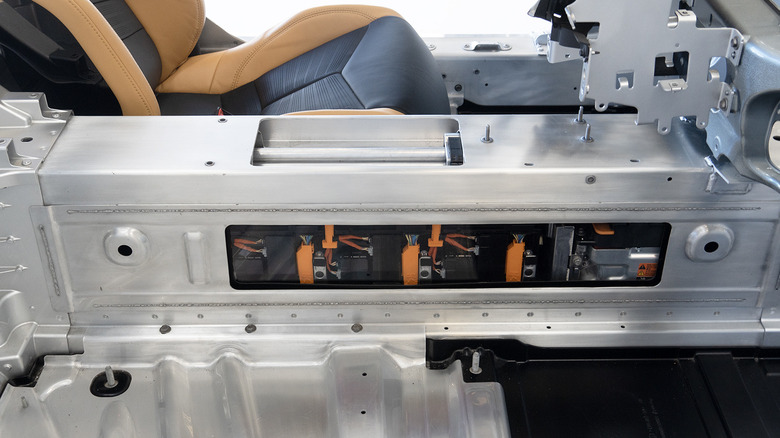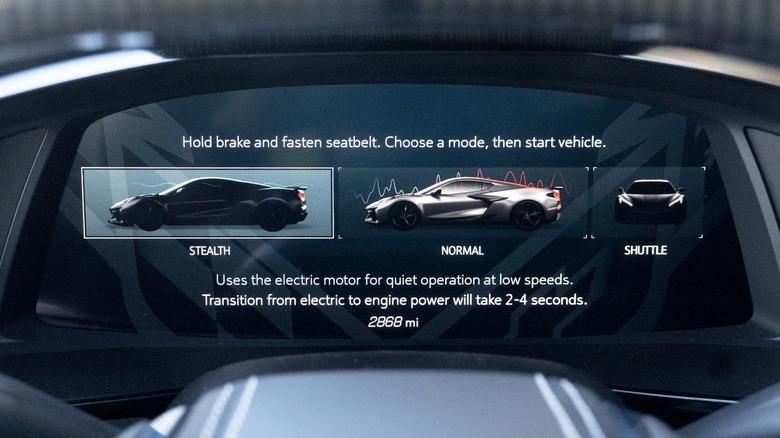Why The 2024 Corvette E-Ray Can Only Go 4 Miles In Stealth Mode
As our 2024 Corvette E-Ray first drive found, it earns the impressive distinction of being the quickest 'Vette in history, thanks to the low-end torque made possible by a hybrid drivetrain and the additional traction provided by all-wheel drive. That hybrid powertrain marks a first for Corvette, now well into the eighth generation that saw a shift to the mid-engined supercar layout, and the performance enhancements are clear: A 0-60 time of 2.5 seconds on the way to a quarter-mile in only 10.5 seconds.
But in addition to the impressive acceleration stats, the E-Ray also adds a few nifty features that leverage the front electric motor almost similarly to a plug-in hybrid, allowing the car to run for short periods of time in two full EV modes. 'Stealth' mode will probably help keep neighbors happy, perfect for pulling out of driveway on early mornings without firing up the big LT2 V8. 'Shuttle' mode, meanwhile, is intended for moving the car around silently at low speeds. How far the E-Ray can travel in these modes depends on battery state of charge, of course, but also a number of key decisions by the Corvette engineering team as well.
Fun tricks with a hybrid Corvette
The E-Ray uses a relatively small battery pack housed in the C8's massive center tunnel. In total, 80 pouches of cells (entirely separate from the 12-volt lithium-ion battery for the ICE V8) produce up to 125 lb-ft of torque when sending power to the front electric motor. But the pack prioritizes temperature control while discharging and receiving energy, rather than all-out range—typically using a maximum of only 1.1 kilowatt-hours out of a total capacity of 1.9 kilowatt-hours.
In fact, the compact battery pack almost persuaded Corvette engineers into nixing any kind of fully electric modes at all, but the usefulness (and fun) of the Stealth and Shuttle modes clearly outweighed the hassle of figuring out how to fire up the engine and light catalysts on the fly (which also presented a challenge when it comes to emissions regulations).
Driving in Stealth and Shuttle modes
The E-Ray's electric and internal-combustion engines power the front and rear axles, respectively, without any mechanical connection. So in the full-EV modes, the car switches to front-wheel drive only—counterintuitively, while driving with the gas engine active, the battery pack can actually charge by "dragging" the front tires a bit with regen. But the minimal capacity versus a more typical plug-in hybrid, for example the Audi Q5 PHEV with its 17.9-kWh battery, makes for minimal range.
Actually turning on the Stealth or Shuttle modes requires little more than turning the drive mode dial before pressing the start button. Stealth works up to 45 miles per hour, but only during light driving—mashing the throttle will fire up the engine, as well going faster than 45 miles per hour or running the battery too low. Depending on driver behavior and state of charge, Chevrolet claims the E-Ray should be able to manage around three to five miles in Stealth Mode.
Shuttle mode, on the other hand, allows only a max of 15 miles per hour and will never fire up the V8 regardless of throttle input. Chevy envisions this mode as perfect for parking in hotels or owners playing car Tetris in garages, and the car will not even ding a seatbelt warning at speeds that low. Full range in Shuttle mode matters less, since going a few miles would take forever, and switching into normal drive mode requires only another spin on the C8's drive mode selector wheel.
Other nifty tricks that hybrid power allows
In the greater context of the current automotive industry, filled with OEMs making tough judgment calls about customer preferences for hybrid systems, the C8 manages to find a middle ground between a performance hybrid and a more "traditional" PHEV—all without requiring the physical act of plugging in to charge. Under hard driving, the system can also help with additional grip and punchier torque delivery by turning off the "Charge+" mode that prioritizes battery and electric motor performance.
The real cost, other than dollars and cents? Well, the hardtop convertible version now tips the scales at a hefty 4,056 pounds, or around 10-15% heavier than the Stingray and Z06 variants depending on specs. Clearly, Chevy believes the E-Ray's performance potential and all-season driveability offset the weight gains of an almost-plug-in hybrid. And owners who do choose an E-Ray over the base Stingray or track-tuned Z06 will no doubt appreciate the convenient addition of Stealth and Shuttle modes to help justify their purchase of the first-ever hybrid, all-wheel-drive Corvette.



